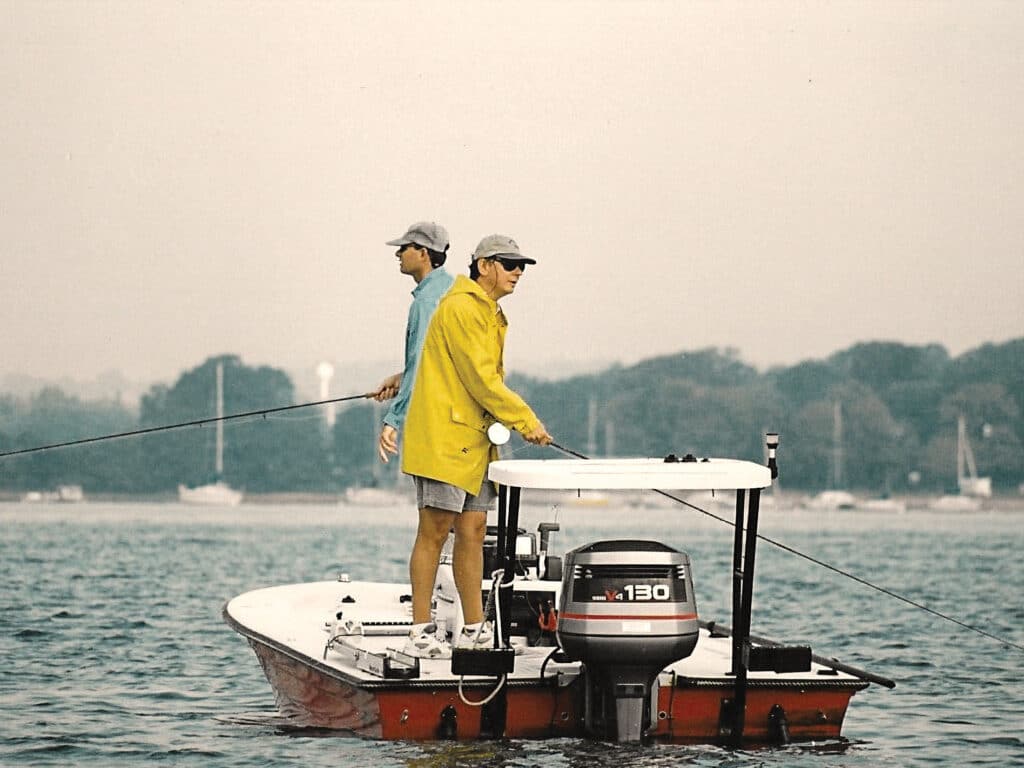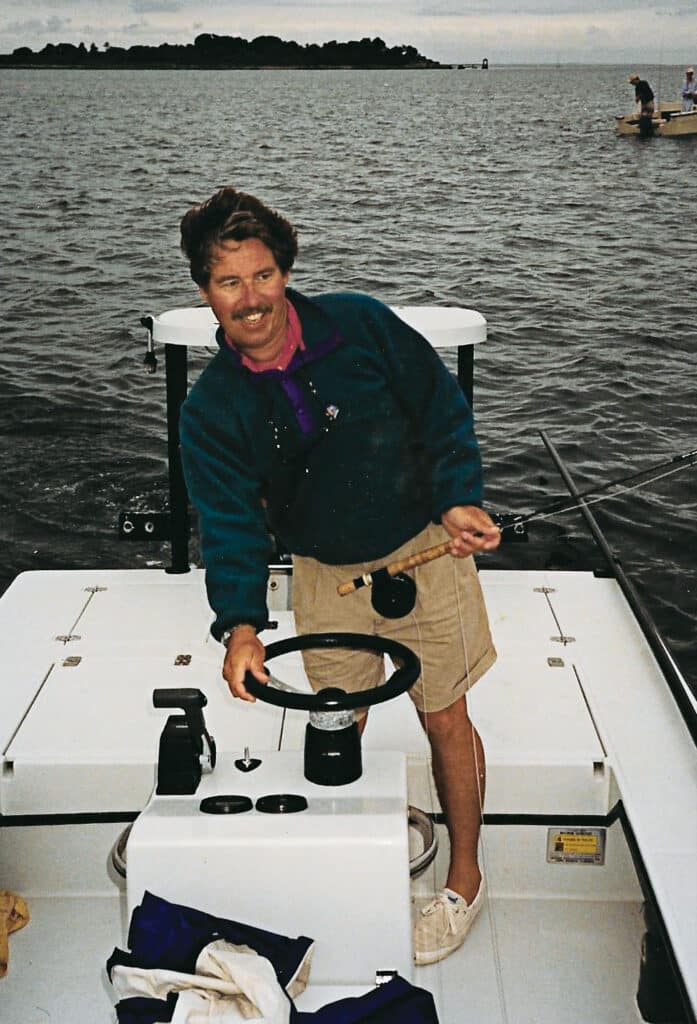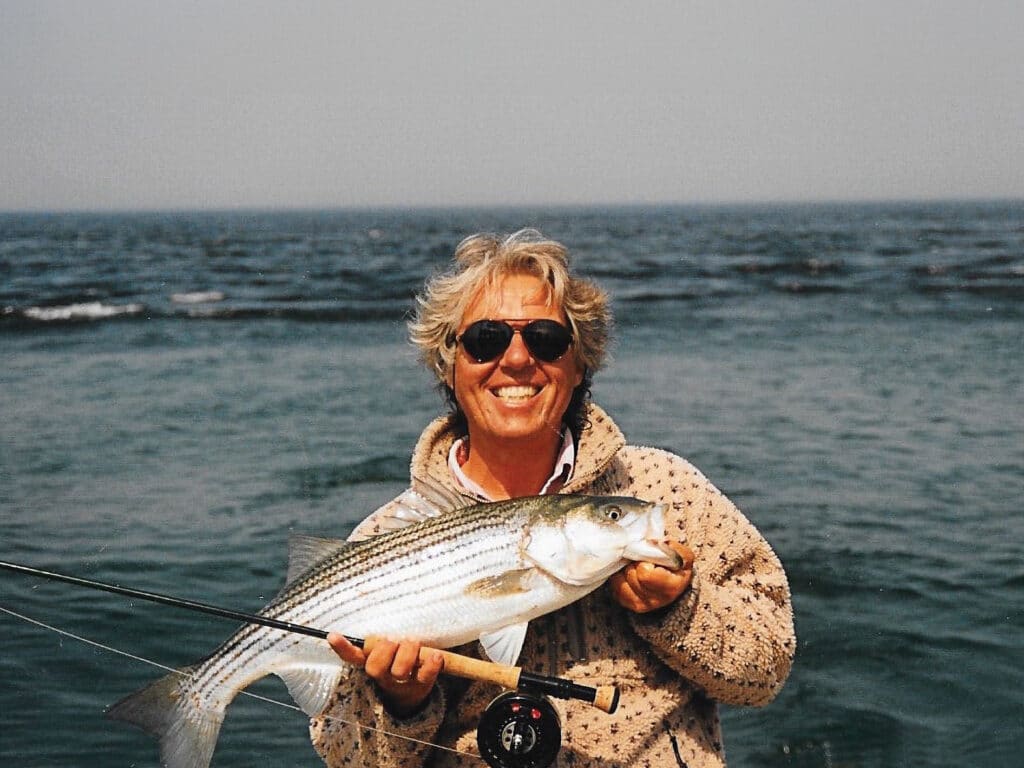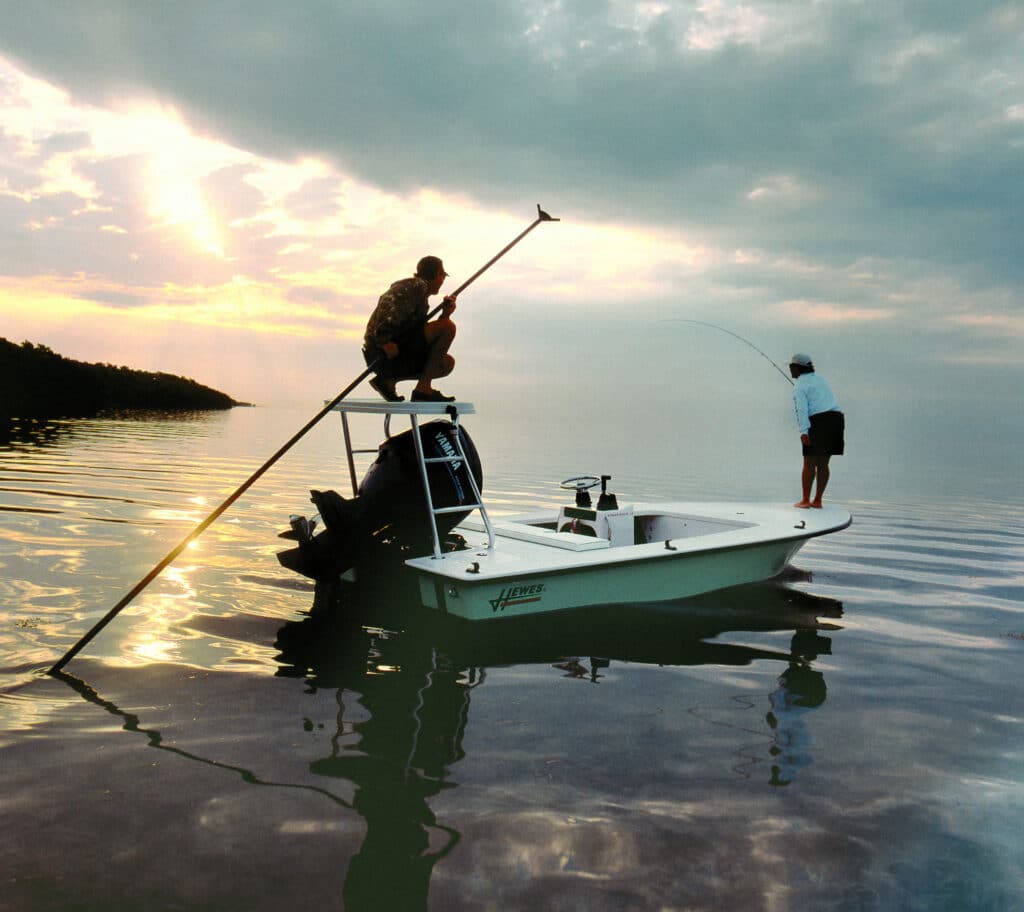
The late 1980s, I first heard about a young guide in Connecticut who fished from a Hewes Redfisher, sight-casting to striped bass in shallow water inaccessible to other types of craft. Capt. Jeff Northrop was based out of Westport, a short train ride from New York City, and many of his clients were wealthy fly-fishermen who worked in the Big Apple.
Intrigued by his novel approach, I got to know Northrop and found him an incredibly knowledgeable and intuitive guide, a wizard with a fly rod. We spent several wonderful days poling skinny water, sight-casting to stripers and huge bluefish, culminating in several articles about him and his unique fishery. All these years later, Northrop is just as enthusiastic and passionate about the fishery he developed through a confluence of life experiences.
Aquatic Roots
Northrop was a rambunctious youth who grew up on the banks of the Saugatuck River, where he started fly-fishing at 12 years of age. His family roots in the Westport area stretch back to pre-Revolutionary War times and include watermen, farmers and landowners with holdings dating back to grants from King George III. Some of his relatives still make their living in the area’s lucrative oyster business, as does he. If you’ve ever eaten Hummock Island Oysters at a fancy restaurant, you’ve enjoyed the fruits of Northrop’s other business.
One day, young Northrop took his trout rod to the shore of the Sound, hooked a fish of indeterminate size, and lost his fly, leader, fly line and all the backing. Freshwater fishing was quickly forgotten. He declined college because he wanted to move to the Bahamas, so his stepfather bought him a one-way ticket to Bimini after high school, where he lived for the next six years. Some of that time was spent in the company of the island’s most famous guide and religious guiding light, the Reverend Bonefish Willy. He joined his congregation before becoming a frequent client. From Willy he learned about bonefishing and the vagaries of fish in shallow water.

Messing About in Boats
Upon his return to Westport, he started Northrop Yacht Sales as a small marina and boat brokerage with his wife, Tomi Ann. He became an Aquasport dealer, rigged a stripped-down 17-foot center-console for fly-fishing, and started poling it for charter clients. But it proved too heavy to get into the real skinny water that abounds around the Norwalk Islands.
At the 1986 Miami Boat Show, Northrop approached Scott Deal, president of Maverick Boats, and inquired about becoming a dealer. Deal thought he was crazy, and Northrop walked away to the sound of laughter. But they would meet again later that day; this time, Deal asked if he would be interested in representing Hewes Boats, which Deal was in the process of acquiring.
A deal was struck, and Northrop’s first four Hewes flats skiffs arrived in Connecticut in early 1987. One went to Outdoor Life editor Jerry Gibbs, another to close friend Warren Stern, and Northrop kept a bright-red Redfisher for his fledgling charter service. Sales picked up as local fishermen and would-be guides heard about the fish he was catching in places where other boats feared to tread. In the following years, the Sound rocked with shiny new flats boats courtesy of Northrop’s dealership and fishing prowess.
The Norwalk Islands area is unforgiving, littered with rocky reefs and random boulders hidden under very shallow water that make most of the prime flats accessible only with a technical poling skiff. By the mid-1990s, the docks at Northrop’s marina held upward of 50 flats boats, with a dozen skiff guides operating there, a testament to the skiff’s usefulness in the region.
Jeff and Tomi remained the only Hewes/Maverick dealer north of Florida until providence arrived in the form of a wealthy businessman who wanted to buy their marina, boat dealership and lucrative saltwater fly shop. The offer was too good to pass up, so they sold in the spring of 2008 and later began developing their oyster business. The economy faltered later that year, and Northrop continued guiding clients from a succession of Maverick skiffs. Today, as a fit 70-year-old, he charters on a regular basis, hunting bass, bluefish and false albacore for his clients.

Full Circle
Some 34 years later, I find myself perched on the bow of Northrop’s latest Maverick technical poling skiff, fly rod in hand, scanning the mirror-calm surface of a cove, watching for the subtle ripples that might reveal a school of tiny sand eels cruising below the surface in barely a foot of water. Northrop has the same gregarious and excitable presence, pointing out the reef edges, sand flats, and missed strikes from school stripers I didn’t even see—just as he did all those years ago when we first met.
After the fishing revolution he started in the Norwalk Islands region, Northrop has gone from being the first skiff guide in the Northeast to the last in that area of the Sound, as the others have all retired or moved on. But his influence didn’t end there. Along the way, he helped others learn about shallow-water striper fishing in areas on Long Island’s East End and Cape Cod’s Monomoy. He sold many of them their first skiffs, and a few, like famous Montauk guide Capt. Paul Dixon, have remained lifelong friends.
“The fishery in the western Sound has gone through monumental changes over the years,” Northrop recounts. “The striper fishery has been influenced by fluctuations in population, and bait availability has changed their movements in this area. As part of the nursery area for Hudson River-spawned bass, the majority found here in skinny water are in the sub-28-inch class and feeding on sand eels.
“There was a long stretch when big bluefish invaded the shallows around the Norwalk Islands. Imagine 12- to 20-pound blues finning in a foot or two of water, eager to smash flies, then tail-walk and strip line like tarpon. It was insanity.”
Northrop recounted a day with noted writer Dean Travis Clarke aboard his skiff. Clarke made nine casts and hooked nine 16-plus-pound bluefish that literally left him exhausted but smiling. We encountered big bluefish finning on the surface the first day Northrop and I reunited, but it was out in the open Sound, in deeper water. They come in to spawn, and when it’s calm, they readily attack big flies or surface plugs on light spinning tackle. They have shied away from the shallows along the Connecticut shoreline the last few years, but they could return in the future.
“The last couple of years, the fall fishing for bass has been excellent in the shallows. We’ve even had bass blitzing on peanut bunker again,” Northrop continues. “There were some of the best albacore runs we’ve seen in a long time, with football-field-size schools of them on the surface. Catching them on fly is fantastic sport. My clients have set several fly records over the years, including one for albacore, and it looks like that fishery is on the upswing again.”
Shallow-water fishing in the area has always evolved, and no one knows that better than Northrop. He continues to watch the waters he grew up fishing and nurturing throughout his life, staying attuned to the ebb and flow of this unique fishery. I know I will be back to fish with him again this fall for bass and albacore. There are few types of fishing more challenging than sight-casting from the bow of a poling skiff, and I can’t think of anyone I’d rather share the experience with than the master of the Northeast flats, Capt. Jeff Northrop.
Read Next: A Guide to the Striped Bass Seasons and Migrations

Evolution of the Technical Poling Skiff
Northrop may have brought the first flats boats to the Northeast, but their lineage goes back to the early 1950s, when Bob Hewes built a small boat to tow his daughter, a competitive water-skier, around the canals near his home. It was light, handled a powerful outboard, and stayed on plane in corners. Fishing guides who worked the flats of nearby Biscayne Bay realized the boats ran in very shallow water, so raised casting decks and poling platforms were added, and the Hewes Bonefisher was born—the first flats fishing boat.
Along the way, flats boats underwent a divergence between backcountry models and technical poling skiffs. The former are larger, heavier, and not as stealthy. The latter are lighter, quieter, and capable of getting into extremely skinny water with nary a ripple. Today the Maverick Boat Group manufactures both Hewes and Maverick flats boats and is the largest boat-maker in these genres. It has pushed the envelope of technical poling skiff performance through design and construction improvements. Charlie Johnson, director of marketing and a devotee of shallow-water boats, ran us through some of those improvements.
“Backcountry boats have pretty much morphed into bay boats, like the larger Hewes and our Pathfinder models. They can get into relatively shallow water but utilize trolling motors to maneuver. Technical poling skiffs remain unique to very specific fisheries,” Johnson says. “Lighter, faster, quieter are the hallmarks of a poling skiff and the driving force behind their evolution. Early skiffs had hard edges and utilized the materials and construction techniques of the day, which meant they were heavy and harder to pole. Water would slap the hull while running and at rest, creating noise—the last thing you want in very shallow water. Later Hewes and Maverick designs featured no hard edges at or below the waterline, and weight savings were accomplished using carbon-fiber and Kevlar cloths and VARIS construction, a process of resin infusing that optimizes the resin-to-cloth ratio for a stronger, lighter hull and deck assembly.”
Modern technical poling skiffs, like the Maverick models Northrop runs today, are the epitome of the art and ideal for making stealthy approaches into places where the fish he seeks are at their most vulnerable and wary. How stealthy? When a fish takes a fly literally alongside the boat in 10 inches of water, that’s stealthy!










